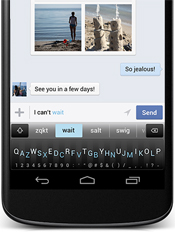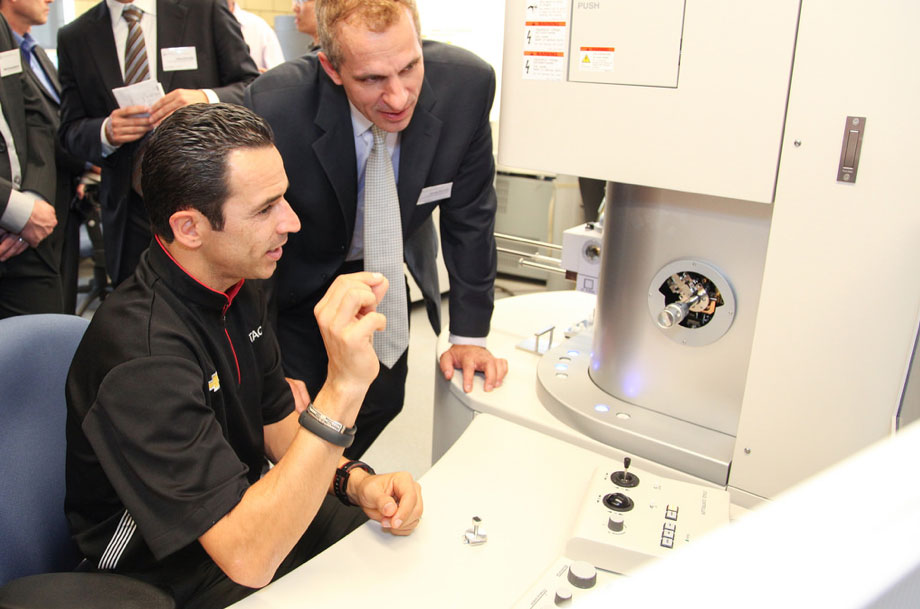Whether you’re a Baby Boomer, a Gen Y or somewhere in between, your age group is characterized by its unique strengths, weaknesses and impacts on society. The current cohort, born after 1995 and dubbed “Generation Z,” have been heralded in Maclean’s Magazine as potentially “the most ambitious yet.” Now, as they navigate high school and pursue higher education, parents and educators explore novel and enticing ways to enable these forward thinkers with skills to address the challenges bestowed upon them by prior generations. U of T’s Da Vinci Engineering Enrichment Program (DEEP) hopes to do just that, tasking high-school students – now Gen Zs – with hands-on, team based challenges that give insight into engineering at the university level. Instructor Patricia Sheridan (BASc 0T9, MASc 1T1), PhD student at the Institute for Leadership Education in Engineering (ILead), teaches a course titled “Leading Engineering Innovation: Strategies for Success,” at DEEP. An alumna of the program herself, Sheridan discusses the importance of enabling this unique generation to be effective leaders and team members with U of T Engineering.
Why do you think skills like teamwork and leadership are important for engineers?
We live in a highly interconnected world where the challenges that engineers will face are larger, more complex and have more significant social impact than ever. It is vital for them to know what is important to them as individuals and as engineers, and what their personal value is in order to sell themselves and find areas for personal improvement. Focusing these students early on at seeking an area at the intersection of their skills and passions will give them a great head start in discovering what they want to do and what to look for in teammates and collaborators.
Would you agree with Maclean’s Magazine on their outlook that this generation is the most ambitious yet? What leadership strengths have you seen in the DEEP cohort this summer?
The students are so mature, intelligent, and self-aware; it is very rewarding to work with them. The amount of energy and passion they have for what they are interested in really stood out to me. Many stayed back to finish conversations that were started in class, to ask more questions about the topics or to learn more about Engineering at U of T. The questions they asked were very thoughtful, and demonstrated an interest in the subject matter as well as in the value that my answer could provide them.
As a DEEP alumna, can you share with us how the program helped you as a young engineer?
It was important for me to get involved in DEEP as it was an instrumental part of my decision to come to U of T when I was a high school student. Participating in DEEP gave me the opportunity to see the campus, see the types of students and professors that were here and gave me a feel of whether I would fit into the environment or not. I think having this type of opportunity to experience first-hand what a brochure cannot fully capture is an essential part of gathering all the information needed to make an informed decision about which program and university to attend. When I participated in DEEP I saw a high caliber of intellectual, fun-loving and sociable people that I felt I would fit right in with, and, I have, since I came to this university.
What advice do you have for young (future) engineers?
Go out and try new things—you have to see how they feel to know if they work for you! Be open to ambiguity, not getting an answer, or not finding a right answer. The world is not a binary place of right and wrong like high school tests. Find out more about yourself, find out what matters to you, and find ways to live in that space and embrace the ambiguity of the parts you don’t know. Offered over four weeks in the summer months, the Faculty’s Da Vinci Engineering Enrichment Program (DEEP) lets high school students with an aptitude for science and math get a closer look at Engineering at U of T before they even apply. Taught by graduate students in the Faculty, DEEP provides young people from around the world with the opportunity for advanced study in a variety of engineering, technology, business and science disciplines. For more information on DEEP Summer Academy, please visit the Engineering Outreach website.

With the latest LED technology, tomorrow’s televisions and smartphones are set to be thinner and more flexible than ever. And now, thanks to a startup from U of T Engineering alumni, they could be more affordable as well.
OTI Lumionics is one of 11 startups – two of which hail from Engineering – that recently completed U of T’s elite accelerator program, Creative Destruction Lab, based at the Rotman School of Management.
The fledgling enterprises spent the last eight months developing various technical and business aspects of their companies, while meeting with Canadian business and entrepreneurship titans. The Lab focuses on preparing ventures for success, as well as connecting them to early-stage investors.
With two cohorts graduating from the program so far, the Lab claims that graduated ventures have already collectively generated approximately $130 million in equity value (value of a company to owners or shareholders).
“We are excited to see how much the second cohort of ventures has grown since they first applied back in September 2013,” said Jesse Rodgers, director of the Lab. “We had an increase in both the overall quality and quantity of applications this year, and it was really great to see eleven ventures successfully complete the program.”
Learn more about two of this year’s Engineering-related startups:
 OTI Lumionics
OTI Lumionics
Forget your clunky television, tablet or smartphone. With organic light-emitting diodes (OLEDs), digitals displays can be as thin and flexible as a sheet of paper.
U of T Engineering alumni startup OTI Lumionics is working on unlocking the full potential of OLEDs through innovative equipment, materials and processes.
OTI president Michael G. Helander (EngSci 0T7, MSE PhD 1T2), development vice-president Xiaofeng Terry Xu (MASc MSE 1T12) and their team are reducing the cost of OLED technology. This could open up new possibilities for use across a wide array of industries, including lighting, displays, solar cells and more.
“Our patented solutions eliminate the bottleneck in traditional OLED manufacturing, enabling low-cost and high-volume mass production,” reads the company’s website.
 Whirlscape
Whirlscape
You wouldn’t want a keyboard blocking half your desktop screen – so why do we put it with it for our smartphones and tablets?
Minuum, developed by the startup Whirlscape, is a tiny intelligent keyboard that takes up a fraction of the space on portable electronics. Predicting text with high accuracy, the single-line keyboard blasted beyond its Indiegogo crowdfunding campaign by 873 per cent.
Two of the company’s three co-founders come from U of T Engineering: Xavier Snelgrove (EngSci 1T1) and William Walmsley (MASc MIE 1T2).
“It’s really about the user’s expectations of the keyboard,” Walmsleytold online magazine The Verge. “Most of the frustration that happens when you’re using an iPhone keyboard is because you’re shown these distinct buttons, and you feel like you’re supposed to use it like a typewriter where you need to hit every button every time.
“But that’s completely unrealistic, because when you’re using a phone that’s that small, you’re going to be making mistakes all the time anyway. So by making the keys even smaller, really we’ve changed the user’s mindset to be aware that they’re supposed to miss every time… it’s the understanding that the system is always working with them to correct their spelling.”
[youtube https://www.youtube.com/watch?v=niV2KCkKmRw]
Read more about this Creative Destruction Lab cohort’s 11 startups.
About the Creative Destruction Lab
Founded in 2012 by ProfessorAjay Agrawal, the Creative Destruction Lab at the Rotman School of Management leverages leading faculty and industry networks, inventions, and talent from world-class, technology-oriented faculties at the University of Toronto as well as its location in Toronto, one of the world’s most culturally diverse cities and Canada’s largest financial centre.
The Rotman School of Management at the University of Toronto is redesigning business education for the 21st century with a curriculum based on Integrative Thinking. Located in the world’s most diverse city, the Rotman School fosters a new way to think that enables the design of creative business solutions.

in the world.
Want faster Internet? Professor Wei Yu (ECE) is on the case.
Professor Yu was recently named to Thomson Reuters’ rankings of the most highly cited scientific researchers in the world, one of 19 University of Toronto professors to make the list. He was included in the Computer Science category, which selected just 117 top thinkers from around the globe.
“I’m drawn to research in communication theory, both because of the beauty of the mathematical theory of communications, and because the enormous practical impact communication technologies have had in our society,” said Professor Yu. “This is a rare combination that makes scientific pursuits in this area so rewarding.”
Professor Yu’s research focuses on information theory and wireless communications, and he is the current Canada Research Chair in Information Theory and Wireless Communications. His work aims to develop systematic tools for the design, analysis, and optimization of wireless cellular systems. Professor Yu has published several highly cited research papers devoted to uncovering the fundamental capacity limits of communication scenarios, so as to derive insights that propel and evolve the future of wireless networks.
According to Google scholar citations, Professor Yu has received almost 10,000 citations.
Thomson Reuters is a multinational data and media company. It selected its most influential researchers by considering “highly cited papers,” definted as “those that rank in the top 1% by citations for field and year indexed in the Web of Science.” Learn more about their methodology.

Airlines Flight MH17 which crashed in the Ukraine on July 18, 2014
killing all 298 people on board (Photo: Roman Boed via Flickr).
Nearly a week after the Malaysian Airlines flight MH17 was destroyed over Ukraine, questions abound over what exactly happened.
Writer Jelena Damjanovic spoke to U of T engineering professor Doug Perovic (MSE) and anthropology professor Tracy Rogers about the procedures − and the challenges − of gathering scientific evidence and performing accurate analysis to determine the causes of such tragedies.
Perovic is a materials science & engineering professor and a renowned expert in forensic engineering. He currently teaches the only forensic engineering course in Canada, where he challenges students to apply engineering design concepts to real-world problems – learning the tools they need for high-level sleuthing.
Rogers is a forensic anthropologist and director of the forensic science program at the University of Toronto Mississauga. She’s helped identify remains found at the farm of serial killer Robert Picton.
What evidence might the bodies of the passengers provide about the tragedy?
TR: The information provided by the bodies of the victims would be most useful if the bodies were actually examined in place at the scene. The distribution of the remains, along with the patterns of injuries they sustained can help investigators sort out the sequence of events.
Knowing the seat number of each victim, and examining injuries in light of the person’s position on the plane, could provide some insight into which areas of the plane were most impacted.
The usefulness of this type of analysis will depend on the overall degree of destruction and degree of decomposition that has already taken place.
What evidence, if any, can be gleaned once bodies have been moved by non-professionals after decomposing for days?
TR: That is very difficult to say. It really depends on what they are trying to learn. Mainly they will be concerned with identification of the bodies, but some of the injury patterns might be informative – even information like whether or not the body was burned could be useful.
Now that the bodies have been moved from the scene, the investigators will have to ID the bodies to find out who they are, link that info to their seat placement and then examine the injuries to see if they can provide insight into where or how the plane was hit, etc. But the plane itself may prove more useful for this type of analysis.
What methodology and technology would be used to determine the cause of a plane crash?
DP: Let me outline some of the key steps to any investigation:
- Investigators employ the root cause failure analysis (RCFA) procedures.
- All available and relevant background information and data are collected.
- All physical evidence available is collected and reassembled as best as possible to reconstruct the aircraft structure.
- The origin of the failure event is then determined using a wide range of characterization tools, involving spectroscopy, microscopy, etc. as needed.
- The initial cause of the event is determined by analyzing the origin and using a cause-and-effect RCFA approach. This involves assessing all possible causes and the resultant effects, and then eliminating the possibilities to the most probable cause.
- Ultimately, the history of the event from beginning to end is determined in order to fully assess liability and damages.
Who is typically involved in investigating the causes of plane crashes – what bodies or institutions? What about instances when an aircraft crashes over a war zone?
DP: The federal authority of the country where the accident occurred takes the lead. Usually the National Transportation Safety Board (NTSB), Federal Aviation Administration (FAA), aircraft manufacturer and pilot associations are involved.
A crash over a war zone is clearly a problem for the normal course of events. The physical evidence has to be immediately secured and not disturbed until properly documented by experts to do the types of analyses outlined above. I understand that is not the case in Ukraine.

What if you could dim the lights across your entire house without having to buy dimming switches – and save the environment too?
Thanks to the latest invention from Nanoleaf, a startup from U of T Engineering alumni, you soon can.
Nanoleaf, creators of the world’s most efficient light bulb, has released a new dimmable LED bulb that can “transform” any on/off light switch into a dimmable switch. Called the Nanoleaf Bloom, the device is part of a Kickstarter campaign that recently blasted beyond its funding goal in less than two hours.
“In the past, with regular light switches, people had no choice but to use their lights either at full power or completely off,” said Nanoleaf co-founder Gimmy Chu (ElecE 0T6). “With our latest innovation, we not only give people the convenience of having the ability to adjust the brightness without the need for a dimmer … we enable them to save a significant amount of energy.”
The bulb screws into a typical light socket, and it can be dimmed by clicking the light switch on and off in certain combinations. The team estimates the new bulb will cost approximately $1.53 in energy per year.
“One of the coolest parts about our bulb is that at half brightness, it only uses a quarter of the full power,” he said. “At the lowest brightness, the Nanoleaf Bloom only uses half a watt of electricity… and it is still the world’s most energy efficient.”
Nanoleaf was first profiled by U of T in February of 2013. That’s when a Kickstarter campaign for the first bulb from Chu and his co-founders, fellow engineering alumni Christian Yan (ElecE 0T6) and Tom Rodinger (IBBME PhD 0T7), began to draw investments well beyond their original $20,000 goal.
Since then, the team scored influential global funding from the likes of Li Ka Shing (dubbed “Asia’s richest man” by Bloomberg news) while keeping the U of T connection alive, adding three new team members from the university and name-checking the support of President Meric Gertler when speaking with international media.
“I think people are drawn to the high energy efficiency design of our bulb as well as our story – a David vs. Goliath sort of thing – you know, just three entrepreneurs with no funding and just a bright idea,” Chu told U of T News in an article about the global funding.
“We used our passion for efficiency to build a light bulb that was well ahead of the competition. I’m actually surprised that the bigger companies haven’t hit our efficiency rates yet, but sadly I don’t think efficiency is their primary focus.”
Chu shared plans for the dimmable bulb in the U of T News story in March. Now that it’s launched, their latest product continues to rack up Kickstarter funding as they surpassed their original target of $30,000 in less than two hours.
“We want to inspire people to adopt more energy efficient technology into their everyday lives,” said co-founder Christian Yan. “The best way to do that is by making products that are simple and convenient to use.”
[youtube https://www.youtube.com/watch?v=eizpVPlS32E]

When three-time Indy 500 winner Hélio Castroneves speeds around the track at this month’s Indy races, he’ll be driving a racecar propelled by decades of materials research that makes him faster, safer and more efficient.
But with the opening of a new $20-million materials lab at the University of Toronto, the technology in Castroneves’ car could soon feel as old-fashioned as your grandma’s station wagon.
On July 17, Castroneves joined U of T Engineering to unveil the Ontario Centre for Characterization of Advanced Materials (OCCAM) – a high-tech facility that enables researchers to explore and develop novel materials that could be used in electronics, renewable fuels, construction, disease treatment and even futuristic racecar design.
Funded by the Canada Foundation for Innovation (CFI), the Ontario Ministry of Research and Innovation (MRI) and Hitachi High-Technologies Canada, OCCAM offers highly specialized tools to understand and manipulate matter at the atomic scale. The centre also emphasizes collaborative and multidisciplinary projects, anticipating over 350 different research programs annually involving academic researchers and private companies.
“This is expensive equipment to purchase and operate, but the new centre makes it available to everyone, from industry to academia,” said Professor Charles Mims (ChemE), a co-principal investigator for OCCAM alongside Professor Doug Perovic (MSE). The facility is a joint initiative between the Department of Materials Science & Engineering (MSE) and the Department of Chemical Engineering & Applied Chemistry (ChemE).

To celebrate OCCAM’s grand opening, Castroneves used one of the lab’s high-power electron microscopes to “cut” the centre’s name into a ribbon at nano-scale. The width of each letter was nearly 1,000 times smaller than a human hair.
The MSE logo will also be featured on the front of the racecar of Castroneves – part of the Hitachi-sponsored Penske Team – at this weekend’s Honda Indy Toronto races.
“OCCAM is a shining example of how U of T Engineering, in partnership with industry and government, is pursuing innovative solutions to some of world’s greatest challenges in health, city life and energy,” said Dean Cristina Amon. “We are profoundly grateful to CFI, MRI and Hitachi for their contribution to the creation of this unique world-class facility.”
Three big (and small) ideas enabled by OCCAM:
1. Car accidents that no longer kill people
“We have the technology today to make vehicles so safe that car accidents no longer kill people,” shared Professor Perovic. But if we have the means, why aren’t we using them? According to Perovic, the answer is cost – cost of materials and cost of manufacturing. That’s why, through OCCAM, he has partnered with Toronto-based Integran Technologies to develop newer, inexpensive methods of boosting vehicle safety and efficiency.
Integran is the only company in the world that can coat plastic and carbon fibre with nano-metals, allowing them to make virtually any material significantly stronger with one coating. While they are continuing to find ways of reducing cost, Integran’s technology has the potential for impact beyond the auto industry, from better spacecraft to lighter and more durable bicycles.
2. Stopping blood clots with non-stick nano-materials
Blood clots are essential in healing cuts, but they can be deadly for those requiring medical catheters (tubes that carry medicine or drain fluids in the body). Dangerous clots can form around the tubes in a process called thrombosis – an affiliction that leads to approximately 50,000 deaths in the United States each year.
To reduce the risk of blood clots, Professor Paul Santerre (IBBME), Jeannette Ho (ChemE/ IBBME MASc 9T7) and a group of other medical scientists and engineers have designed a method of producing catheters that include fluorinate oligomers, the same molecules that make frying pans non-stick. Already commercially available through licensing from Santerre’s spin-off company Interface Biologics, their invention has shown to reduce the rates of thrombosis by up to 75 per cent.
“OCCAM gives us access to tools and expertise that a small lab like us wouldn’t normally have,” said Roseita Esfand, director of research and development at Interface. “Collaborations such as this will help us to bring our technologies and products from bench to human.”
3. Solar fuels – If trees can do it, we can do it
Professor Ben Hatton (MSE) and group of multidisciplinary researchers are using OCCAM’s advanced equipment to design nano-materials that mimic the photosynthetic processes of plants. While plant photosynthesis uses the sun’s rays to produce sugars and carbohydrates, Hatton’s lab is hoping to make materials that produce methane and other gases.
This technology could be used to power vehicles, houses and more – and to store energy we aren’t using for later consumption. In doing so, they could reduce, and even reverse, the detrimental impacts of fossil fuels. “We’re still in early development stages,” explained Hatton. “But we’re excited by the advances and resources that OCCAM will provide, and we look forward to making our technology better and more efficient.”
“If trees can do it,” he said, “we can do it.”
